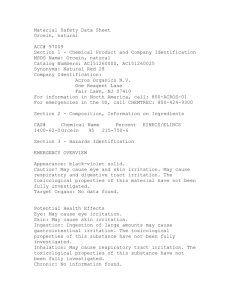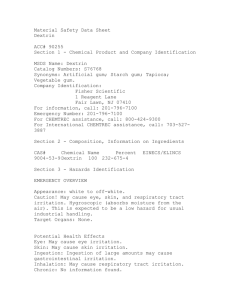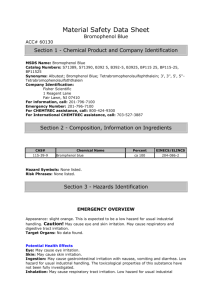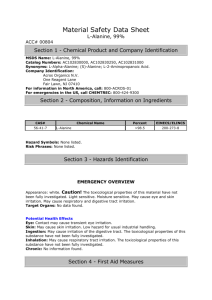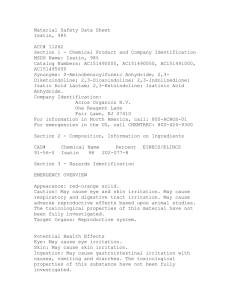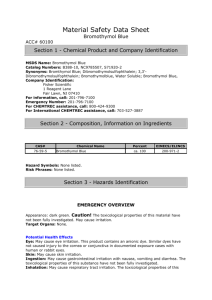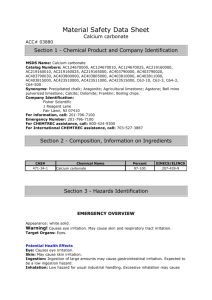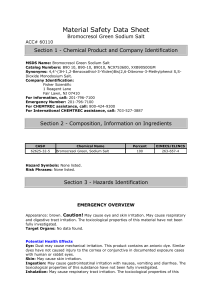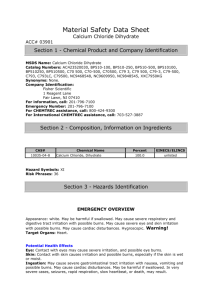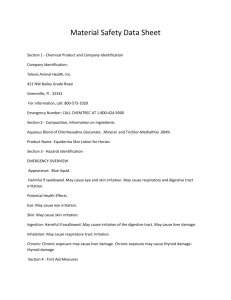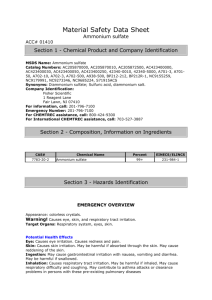Calcium (turnings)
advertisement
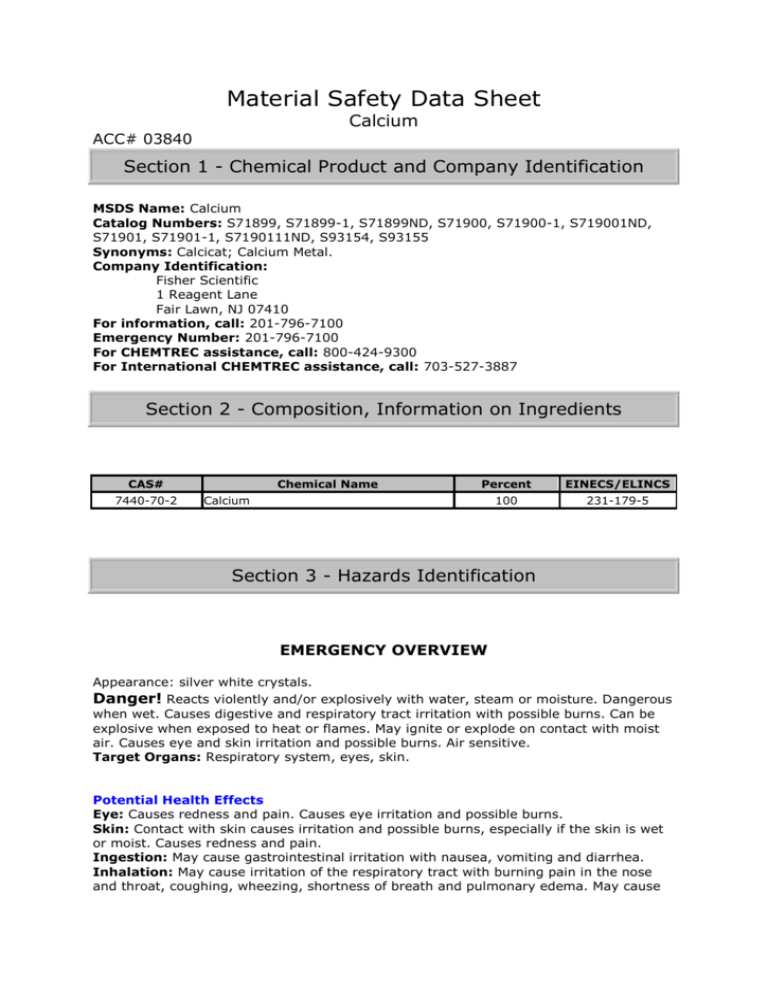
Material Safety Data Sheet Calcium ACC# 03840 Section 1 - Chemical Product and Company Identification MSDS Name: Calcium Catalog Numbers: S71899, S71899-1, S71899ND, S71900, S71900-1, S719001ND, S71901, S71901-1, S7190111ND, S93154, S93155 Synonyms: Calcicat; Calcium Metal. Company Identification: Fisher Scientific 1 Reagent Lane Fair Lawn, NJ 07410 For information, call: 201-796-7100 Emergency Number: 201-796-7100 For CHEMTREC assistance, call: 800-424-9300 For International CHEMTREC assistance, call: 703-527-3887 Section 2 - Composition, Information on Ingredients CAS# 7440-70-2 Chemical Name Percent EINECS/ELINCS 100 231-179-5 Calcium Section 3 - Hazards Identification EMERGENCY OVERVIEW Appearance: silver white crystals. Danger! Reacts violently and/or explosively with water, steam or moisture. Dangerous when wet. Causes digestive and respiratory tract irritation with possible burns. Can be explosive when exposed to heat or flames. May ignite or explode on contact with moist air. Causes eye and skin irritation and possible burns. Air sensitive. Target Organs: Respiratory system, eyes, skin. Potential Health Effects Eye: Causes redness and pain. Causes eye irritation and possible burns. Skin: Contact with skin causes irritation and possible burns, especially if the skin is wet or moist. Causes redness and pain. Ingestion: May cause gastrointestinal irritation with nausea, vomiting and diarrhea. Inhalation: May cause irritation of the respiratory tract with burning pain in the nose and throat, coughing, wheezing, shortness of breath and pulmonary edema. May cause severe respiratory tract irritation and possible burns. Chronic: No information found. Section 4 - First Aid Measures Eyes: Flush eyes with plenty of water for at least 15 minutes, occasionally lifting the upper and lower eyelids. Get medical aid. Do NOT allow vi ctim to rub eyes or keep eyes closed. Skin: Get medical aid. Flush skin with plenty of water for at least 15 minutes while removing contaminated clothing and shoes. Wash clothing before reuse. Destroy contaminated shoes. Ingestion: Do not induce vomiting. If victim is conscious and alert, give 2-4 cupfuls of milk or water. Get medical aid immediately. Inhalation: Get medical aid immediately. Remove from exposure and move to fresh air immediately. If not breathing, give artificial respiration. If breathing is difficult, give oxygen. Do NOT use mouth-to-mouth resuscitation. If breathing has ceased apply artificial respiration using oxygen and a suitable mechanical device such as a bag and a mask. Notes to Physician: Treat symptomatically and supportively. Section 5 - Fire Fighting Measures General Information: As in any fire, wear a self-contained breathing apparatus in pressure-demand, MSHA/NIOSH (approved or equivalent), and full protective gear. During a fire, irritating and highly toxic gases may be generated by thermal decomposition or combustion. Water Reactive. Material will react with water and may release a flammable and/or toxic gas. This chemical poses an explosion hazard. Reacts with water to form explosive hydrogen gas. May ignite or explode on contact with steam or moist air. May re-ignite after fire is extinguished. Extinguishing Media: Do NOT get water inside containers. Contact professional firefighters immediately. Cool containers with flooding quantities of water until well after fire is out. DO NOT USE WATER OR FOAM. For small fires, use dry chemical, soda ash, lime or sand. For large fires, use dry sand, dry chemical, soda ash or lime or withdraw from area and let fire burn. Flash Point: Not applicable. Autoignition Temperature: Not applicable. Explosion Limits, Lower:Not available. Upper: Not available. NFPA Rating: (estimated) Health: 3; Flammability: 1; Instability: 2; Special Hazard: W- Section 6 - Accidental Release Measures General Information: Use proper personal protective equipment as indicated in Section 8. Spills/Leaks: Vacuum or sweep up material and place into a suitable disposal container. Avoid runoff into storm sewers and ditches which lead to waterways. Clean up spills immediately, observing precautions in the Protective Equipment section. Avoid generating dusty conditions. Do not expose spill to water. Place under an inert atmosphere. Section 7 - Handling and Storage Handling: Wash thoroughly after handling. Use only in a well-ventilated area. Do not allow water to get into the container because of violent reaction. Minimize dust generation and accumulation. Avoid contact with eyes, skin, and clothing. Avoid ingestion and inhalation. Handle under an inert atmosphere. Store protected from air. Keep from contact with moist air and steam. Storage: Store in a tightly closed container. Store in a cool, dry, well-ventilated area away from incompatible substances. Keep away from water. Do not expose to air. Store protected from moisture. Store under an inert atmosphere. Section 8 - Exposure Controls, Personal Protection Engineering Controls: Use explosion-proof ventilation equipment. Facilities storing or utilizing this material should be equipped with an eyewash facility and a safety shower. Use adequate ventilation to keep airborne concentrations low. Exposure Limits Chemical Name Calcium ACGIH none listed NIOSH OSHA - Final PELs none listed none listed OSHA Vacated PELs: Calcium: No OSHA Vacated PELs are listed for this chemical. Personal Protective Equipment Eyes: Wear appropriate protective eyeglasses or chemical safety goggles as described by OSHA's eye and face protection regulations in 29 CFR 1910.133 or European Standard EN166. Skin: Wear appropriate protective gloves to prevent skin exposure. Clothing: Wear appropriate protective clothing to prevent skin exposure. Respirators: Follow the OSHA respirator regulations found in 29 CFR 1910.134 or European Standard EN 149. Use a NIOSH/MSHA or European Standard EN 149 approved respirator if exposure limits are exceeded or if irritation or other symptoms are experienced. Section 9 - Physical and Chemical Properties Physical State: Crystals Appearance: silver white Odor: none reported pH: Not available. Vapor Pressure: 10 mm Hg @983 deg C Vapor Density: Not available. Evaporation Rate:Not available. Viscosity: Not available. Boiling Point: 1484 deg C Freezing/Melting Point:845 deg C Decomposition Temperature:Not available. Solubility: Decomposes. Specific Gravity/Density:1.54@20°C/4°C Molecular Formula:Ca Molecular Weight:40.08 Section 10 - Stability and Reactivity Chemical Stability: Combines vigorously or explosively with water. May ignite spontaneously if exposed to air or kept in the presence of moisture. Conditions to Avoid: Dust generation, exposure to air, excess heat, exposure to moist air or water. Incompatibilities with Other Materials: Acids, oxidizing agents, carbonates, dinitrogen tetraoxide, halogens, sulfur, chlorine, chlorine trifluoride, fluorine, air, moisture, water, water and mixtures containing water (e.g. aqueous solutions, water). Hazardous Decomposition Products: Irritating and toxic fumes and gases, hydrogen gas, calcium oxide, calcium hydroxide. Hazardous Polymerization: Will not occur. Section 11 - Toxicological Information RTECS#: CAS# 7440-70-2: EV8500000 LD50/LC50: Not available. Carcinogenicity: CAS# 7440-70-2: Not listed by ACGIH, IARC, NTP, or CA Prop 65. Epidemiology: No information found Teratogenicity: No information found Reproductive Effects: No information found Mutagenicity: No information found Neurotoxicity: No information found Other Studies: Section 12 - Ecological Information No information available. Section 13 - Disposal Considerations Chemical waste generators must determine whether a discarded chemical is classified as a hazardous waste. US EPA guidelines for the classification determination are listed in 40 CFR Parts 261.3. Additionally, waste generators must consult state and local hazardous waste regulations to ensure complete and accurate classification. RCRA P-Series: None listed. RCRA U-Series: None listed. Section 14 - Transport Information US DOT Canada TDG Shipping Name: CALCIUM CALCIUM Hazard Class: 4.3 4.3 UN Number: UN1401 UN1401 Packing Group: II II Section 15 - Regulatory Information US FEDERAL TSCA CAS# 7440-70-2 is listed on the TSCA inventory. Health & Safety Reporting List None of the chemicals are on the Health & Safety Reporting List. Chemical Test Rules None of the chemicals in this product are under a Chemical Test Rule. Section 12b None of the chemicals are listed under TSCA Section 12b. TSCA Significant New Use Rule None of the chemicals in this material have a SNUR under TSCA. CERCLA Hazardous Substances and corresponding RQs None of the chemicals in this material have an RQ. SARA Section 302 Extremely Hazardous Substances None of the chemicals in this product have a TPQ. SARA Codes CAS # 7440-70-2: immediate, fire. Section 313 No chemicals are reportable under Section 313. Clean Air Act: This material does not contain any hazardous air pollutants. This material does not contain any Class 1 Ozone depletors. This material does not contain any Class 2 Ozone depletors. Clean Water Act: None of the chemicals in this product are listed as Hazardous Substances under the CWA. None of the chemicals in this product are listed as Priority Pollutants under the CWA. None of the chemicals in this product are listed as Toxic Pollutants under the CWA. OSHA: None of the chemicals in this product are considered highly hazardous by OSHA. STATE CAS# 7440-70-2 can be found on the following state right to know lists: California, New Jersey, Pennsylvania, Massachusetts. California Prop 65 California No Significant Risk Level: None of the chemicals in this product are listed. European/International Regulations European Labeling in Accordance with EC Directives Hazard Symbols: F Risk Phrases: R 15 Contact with water liberates extremely flammable gases. Safety Phrases: S 24/25 Avoid contact with skin and eyes. S 8 Keep container dry. S 43C In case of fire, use limestone powder, sodium chloride or dry sand (never use water). WGK (Water Danger/Protection) CAS# 7440-70-2: 1 Canada - DSL/NDSL CAS# 7440-70-2 is listed on Canada's DSL List. Canada - WHMIS not available. This product has been classified in accordance with the hazard criteria of the Controlled Products Regulations and the MSDS contains all of the information required by those regulations. Canadian Ingredient Disclosure List Section 16 - Additional Information MSDS Creation Date: 5/19/1999 Revision #3 Date: 10/03/2005 The information above is believed to be accurate and represents the best information currently available to us. However, we make no warranty of merchantability or any other warranty, express or implied, with respect to such information, and we assume no liability resulting from its use. Users should make their own investigations to determine the suitability of the information for their particular purposes. In no event shall Fisher be liable for any claims, losses, or damages of any third party or for lost profits or any special, indirect, incidental, consequential or exemplary damages, howsoever arising, even if Fisher has been advised of the possibility of such damages
